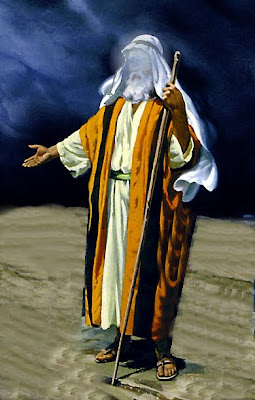MOSES’ RADIANCE

How does proximity to God physically change a person? The story of the radiant face of Moses and the veil he used to cover his face is an interesting story that provides some insight. After Moses destroyed the tablets containing the Ten Commandments in response to the idolatry of the Israelites, he goes back up to be with God and spends forty days and nights without eating and drinking, being sustained by the presence of God. When he returns, his face was radiant, with people being afraid to come near him. Yet this radiance was found to fade with time and he would place a veil over his face to prevent people from noticing the fading glory. When he re-entered the presence of God, the glory would return (Exodus 34:29-35).
While each person does have a spirit- the image of God within him, the physical limitations imposed on him by this world and his body prevent him from being truly united with God. This has been further affected by man’s sinful nature, which puts him at odds with God. And so all we see in the human form is a pale, degraded representation of what ought to be- a glorious creation in the image of God, reflecting the radiance and brilliance of God. Jesus’ transfiguration was an example of his disciples being made privy to the true nature of Christ, which was kept hidden from mortal man. With Christ having no sinful nature unlike other men, he could reveal his true nature at will, which he did at transfiguration, though he kept that nature hidden so that men and women who came into contact with him would not be consumed by his torching glory.
With Moses on the mountain of God, we see a faint glimpse of what can happen when one unites with God. With the proximity of God taking away the shadows imposed by the physical realm and the sinfulness within, Moses began to reflect faintly what he was meant to be. Yet this glory was transient, showing how difficult it is for man to maintain the radiance that emanates from the presence of God. Paul elaborates on this story in 2 Corinthians 3 and gives us further insights as to how this becomes relevant in our lives as disciples of the new covenant.
Now if the ministry that brought death, which was engraved in letters on stone, came with glory, so that the Israelites could not look steadily at the face of Moses because of its glory, transitory though it was, will not the ministry of the Spirit be even more glorious? ……………….We are not like Moses, who would put a veil over his face to prevent the Israelites from seeing the end of what was passing away. But whenever anyone turns to the Lord, the veil is taken away. Now the Lord is the Spirit, and where the Spirit of the Lord is, there is freedom. And we all, who with unveiled faces contemplate the Lord’s glory, are being transformed into his image with ever-increasing glory, which comes from the Lord, who is the Spirit. (v7-18)
For those who believe in Christ, it is the age of the new covenant. We have the indwelling Spirit of God who gives us direct access to God. No longer is required prolonged physical presence in the mountain of God, rather the mountain of God is already within us. The veil between God and man has been taken away, and that was made possible only through Christ. The only limiting factor for man to now reflect the radiance of God is the willingness to be transformed into his image, by submitting to Him and contemplating on Him. And every believer does have the potential to far exceed the glory that was evident on Moses by reflecting a constant presence of God within and the radiance that that brings.
